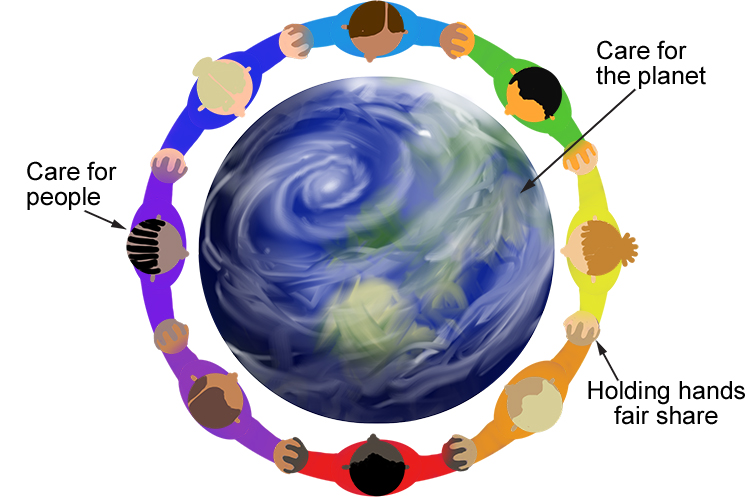Permaculture – A system of agricultural and social design principles based on natural ecosystems
Permanent → ← Agriculture
Perma→ ← Culture
Permaculture
Permaculture is a joining of the words permanent and agriculture.
Permaculture has three core values:
1. Care for the planet
2. Care for people
3. Fair share (not too much and returning surplus)
The way to remember permaculture's three core values is
Care for the planet – see the earth (below)
Care for people – people surrounding the earth
Fair share – equidistant and sharing with each other

Each of the three core values of care for the planet, care for people and fair share must be applied to the following twelve principles:
- See how others have done it (observe and interact).
- Learn to catch and store energy.
- Obtain a yield - including happiness, well-being and family food.
- Apply self-regulation and feedback - reducing, revising, recycling and regulating.
- Don't use fossil fuels - use and value renewables.
- Design from patterns to details, look at the whole thing.
- Produce no waste - recycle rainwater and make compost.
- Integrate, don't segregate. Put different plants together (not one field of one thing).
- Use small, slow solutions. Make small, slow steps.
- Use and value diversity. Go for great variety.
- Use neglected corners, edges and margins.
- Creatively use and respond to change. Adapt to the changing seasons.
The way to remember this is to recall the elements of the following picture:

- See a table with a book open in the middle of the table to indicate "learn from others", see how others have created a permaculture garden.
- A rainwater collector and solar panels help us remember we have to catch water and solar energy.
- The happy gardener and excellent yield of runner beans give a family food and happiness.
- The digging and changing of part of the garden allow us to revise our plans; we can regulate and change ideas from direct feedback.
- Using logs as biomass should help us not to use fossil fuels.
- The circle of garden around the table shows that a permaculture garden likes patterns and you need to design it as a whole.
- The compost bin and water collector is an indicator that in a permaculture garden we recycle rainwater and make compost.
- A variety of plants is needed. You don't want one garden or field full of only one variety of plant.
- The steps up into the garden mean that you go slowly, one step at a time.
- Again the variety of plants should prompt you to remember that diversity is valued.
- See the plants in the very corner of the garden – all neglected corners should be used.
- The greenhouse is a nudge to your memory to remind you to adapt to the seasons.




